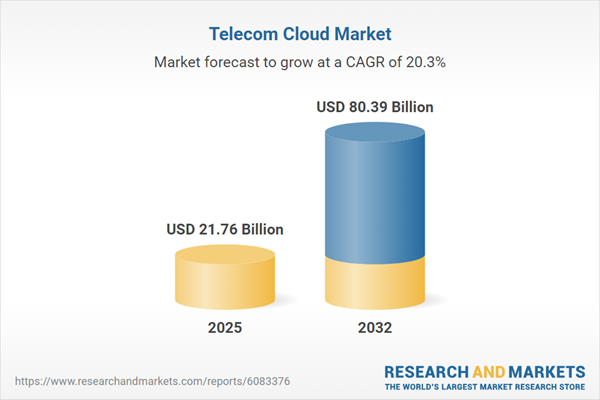Speak directly to the analyst to clarify any post sales queries you may have.
The telecom cloud market is entering a phase of rapid transformation, driven by the urgent need for modern network architectures that enable business agility, smarter service delivery, and seamless scalability across global operators. Advanced cloud-based models are redefining telecom service potential while aligning operations with evolving business goals.
Market Snapshot: Telecom Cloud Market Growth & Outlook
The Telecom Cloud Market grew from USD 18.28 billion in 2024 to USD 21.76 billion in 2025. With a projected compound annual growth rate (CAGR) of 20.33%, it is expected to reach USD 80.39 billion by 2032. This trajectory highlights surging investments in cloud-native network modernization, advanced automation, and strategic partnerships to realize next-generation telecom capabilities worldwide.
Scope & Segmentation: Comprehensive View of the Telecom Cloud Ecosystem
- Component: Platform, Services, Managed Services, Professional Services
- Cloud Service Model: Infrastructure as a Service (IaaS), Platform as a Service (PaaS), Software as a Service (SaaS)
- Cloud Deployment: Private Cloud, Public Cloud
- Application: Content Delivery Network, Data Backup & Recovery, Data Storage & Analytics, Network Security, Traffic Management, Unified Communications
- Organization Size: Large Enterprises, Small & Medium Enterprises (SMEs)
- Vertical: Banking, Financial Services, and Insurance (BFSI), Education, Government, Healthcare, IT & Telecom, Manufacturing, Media & Entertainment, Retail & E-Commerce, Transportation & Logistics
- Geography: Americas (including North America and Latin America), Europe, Middle East & Africa, Asia-Pacific (with specific country analyses)
- Leading Companies: Amazon Web Services, Amdocs, AT&T, BT Group, China Mobile, Cisco Systems, Deutsche Telekom, Google, Huawei, IBM, Juniper Networks, Lumen Technologies, Mavenir Systems, Microsoft, Nokia, NTT Communications, Oracle, Orange S.A., Red Hat, Singtel, Tata Communications, Ericsson, Telstra, Verizon, VMware, Vodafone, ZTE Corporation
Key Takeaways: Strategic Insights for Industry Leaders
- Cloud-native platforms underpin modernization of traditional network functions, driving agile service delivery and reduced operational overhead.
- Collaboration between hyperscale providers and telecom operators supports edge computing and enables rapid rollouts of high-value 5G services.
- Open-source frameworks and established standards are central to ensuring cross-vendor integration, decreasing the risk of vendor lock-in, and fostering innovation.
- Segment adoption varies, as service models and deployment choices are tailored to organizational size, industry demands, and existing technology investments.
- Regulatory demands compel operators to balance cloud adoption speed with compliance and data sovereignty concerns, especially in regions with complex policies.
- Artificial intelligence, automation, and analytics are increasingly embedded in network operations to optimize quality and anticipate customer needs.
Tariff Impact: Navigating U.S. Trade Tariffs in 2025
Recent United States trade tariffs have introduced new constraints for telecom cloud providers, affecting costs for hardware, licensing, and managed services sourced from non-domestic suppliers. This has prompted operators to reevaluate supplier strategies and develop local partnerships. Compliance with these measures increases administrative overhead and lengthens procurement cycles. Industry responses include optimizing procurement frameworks, strengthening domestic innovation, and greater use of open architectures to reduce reliance on specific vendor solutions.
Methodology & Data Sources
This report leverages primary interviews with senior stakeholders, combined with secondary research from public filings, technical white papers, and industry forums. Structured discussions revealed adoption challenges and innovation priorities, while triangulating data enabled robust validation of trends, capacity utilization, and vendor performance. Analyst-led workshops and expert peer reviews ensured accuracy and impartiality in the final findings.
Why This Report Matters
- Gain actionable insights to support cloud migration, edge compute initiatives, and regulatory navigation in telecom networks.
- Assess evolving technology trends and partnership strategies critical for building competitive advantage and operational resilience.
Conclusion
Cloud integration is essential for telecom industry growth, innovation, and adapting to changing regulatory and technology landscapes. Strategic alignment, ecosystem collaboration, and rigorous planning will guide success as telecom cloud adoption accelerates worldwide.
Table of Contents
3. Executive Summary
4. Market Overview
7. Cumulative Impact of Artificial Intelligence 2025
Companies Mentioned
The companies profiled in this Telecom Cloud market report include:- Amazon Web Services, Inc.
- Amdocs Limited
- AT&T Inc.
- BT Group plc
- China Mobile Limited
- China Telecommunications Corporation
- Cisco Systems, Inc.
- Deutsche Telekom AG
- Google LLC
- Huawei Technologies Co., Ltd.
- International Business Machines Corporation
- Juniper Networks, Inc.
- Lumen Technologies, Inc.
- Mavenir Systems, Inc.
- Microsoft Corporation
- Nokia Corporation
- NTT Communications Corporation
- Oracle Corporation
- Orange S.A.
- Red Hat, Inc.
- Singapore Telecommunications Limited
- Tata Communications Limited
- Telefonaktiebolaget LM Ericsson
- Telstra Corporation Limited
- Verizon Communications Inc.
- VMware, Inc.
- Vodafone Group Plc
- ZTE Corporation
Table Information
| Report Attribute | Details |
|---|---|
| No. of Pages | 181 |
| Published | November 2025 |
| Forecast Period | 2025 - 2032 |
| Estimated Market Value ( USD | $ 21.76 Billion |
| Forecasted Market Value ( USD | $ 80.39 Billion |
| Compound Annual Growth Rate | 20.3% |
| Regions Covered | Global |
| No. of Companies Mentioned | 29 |









